

Lockheed L49 Constellation

the beloved
Connie
KLM used the Constellation and the DC6 for their longer routes. It took us three days to get to Amsterdam from Curaçao and the first night after arrival you were floating around in your bed, accustomed as you had grown to the constant motion through the air.
Of the people who were flying in those days (around 1950), I know of no one who only made eventless trips. No boredom here! Willy once had an engine on fire, just like Olaf Stoop of the Real Free Press. I myself once had to make a forced return to Curaçao because one of the engines had run out of control. We spent the night in the Avila Hotel (much-changed, still kicking), where I saw mosquito nets for the first time in my life and where we hardly got any sleep because a gramophone kept playing a top hit titled, ironically enough, Good Night Irene. There were always such long blue flames coming out of the exhausts that legend has it there was a passenger on every flight by night who warned the stewardess an engine was on fire. And they often were right, too.
It was because of much engine trouble
that KLM flyers used to refer to the Constellation asThe best tri-motor airplane in the world.
KLM got to be pretty good at crashing Constellations
some famous cases
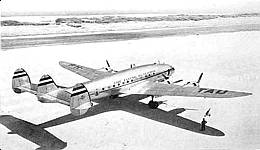
On Hato airport; photo by Fred Fischer
I took out some obstructions in front of the machine
and am sure Fred would have loved that
Starting the motors took some doing. Dig the guy in the shadow of the wing and the fire extinguisher in handy reach. The engines started whining, then spluttered and banged for quite some time before breaking out in a reassuring roar; this had to be done four times, after which the pilot taxied ASAP to the start of the runway where you were treated to the procedure that is almost invariably described as "warming up the motors". It was not; in a place like Curaçao, the crew's main fear was that the engines would overheat. This is why aircraft were parked nose upwind there until at least 1995, when some wise guy finally figured this did not matter for jets, and they stopped turning whole wasteful circles on the tarmac. The ritual at the start of the runway served to check the magnetos, the ignition system. You bring a motor up to full power and switch to the spare system; the motor has to keep running smoothly or you'd better not take off. Repeat for all engines.
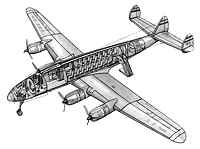
After this, the aircraft, rather leisurely to our jet-accustomed taste, gathered speed. At the wing tips were attached three or four antenna-like wires, extending some 10 centimeters to the back; they may have served to discharge static. These were hanging down at an about 30 degree angle and, as the aircraft picked up speed, gradually assumed a horizontal position, a cue that you had reached take-off speed, and you left the hot concrete runway, which gave lots of lift. You right away passed the coast line, motors still roaring away at full blast, and in the cool ocean air sagged down enough to scare lots of passengers lots of the time.
These babies were noisy.

Photo by Fred Fischer
We were supplied with chewing gum to relieve pressure on the ear drums on take-off and landing, a problem the airlines these days choose to ignore. We were also equipped with paper bags to puke in, labeled "trash bags" to avoid giving suggestible passengers any ideas. It didn't help much. Up in the air, you did not have what you'd call a quiet ride. The DC3, and probably the later Douglas models as well, really were much more stabile than the Constellation. Like Hornblower's ships, she pitched, rolled and corkscrewed. Making your way to the front of the cabin, you were climbing up-hill (the designers bent the fuselage a bit as they thought the nose-wheel strut was quite long enough already). For years, before I knew any better, I went around bragging I helped the stewardess serve a meal in what the cabin crew claimed was the worst storm they'd ever experienced over the North Atlantic. Well, still a pretty good performance...
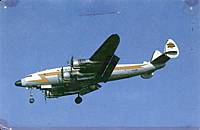
This may be only for the hard-core nostalgically reminiscing fans, and they can find more links on this page. The hard fact is that the flight took so long, it was even more boring than it is now. New York-Amsterdam, 14 hours; which does not include refueling stops - long enough. A DC8 trip Amsterdam-Madrid-Caracas-Curaçao around 1970 still took as long. A good thing was that you really had much more room to move around in than these days, even taking my then much smaller size into account. There was very little entertainment offered except for the two clocks on the back of the cockpit wall (bulkhead - listen, the hell with that, thought Carella), one giving GMT and the other local time, changed halfway, from last take-off to next landing place, or maybe at the at that time often mentioned "point of no return"; a booklet of route maps; and what was commonly referred to as "the KLM-puzzle". This is a rather well-known puzzle where you have to arrange a small number of pieces of cardboard in a 5x5cms square. The last time I ran into it was at the Photokina Köln 1966, where paper manufacturer Turaphot handed them out. If you had the bad luck to solve it right away, that was that. However, it could take you hours, like a later one where you had to make a circle.
| The Square watch it! try to get pieces right way up | The Circle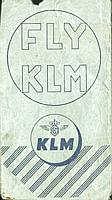 |
Download, print, cut out, have fun!
But inevitably, you spent lots of time looking out of the windows. A thing you can't do now - the Angry Mob will lynch you when you open your window shade, as it washes out their crummy movie screens. At daytime the clouds and wave patterns, at night those exhaust flames. I have spent many hours watching the rubber de-icing strips on the wings keep inflating and deflating, causing the built-up layer of ice to fall off and saving our collective lives in the process.
In Newfoundland, the snow was quite heavy. Bulldozers removed it from the taxiing and take-off runways, but next to those it was so high that from the windows of the Constellation you couldn't look over the top of what looked like this wall of snow. For someone just coming from tropical Curaçao, very impressive. When that Swissair DC10 crashed there in the late 1990s I was terrified by the thought of passengers and crew in that horribly ice-cold, pitch-black water.
After years of jet DC8 and 707, which do not really give you a sensation of being in flight,
flying around in a DC3 for the movie Dakota sure brought back fond memories of those days
"when flying was still dangerous, and fun".
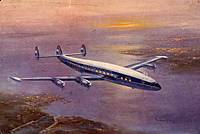
Super Constellation
talk about nostalgia
"No sword's intrinsically more beautiful than the original 049 Connie."
Gavin Lyal - Judas Country
The Super-G Constellation really was a different thing altogether. While there most definitely is a certain resemblance, it had a very advanced (as a matter of fact, plateau: you can go there and not any farther) type of engines that had a turbine in the exhaust to add the wasted power of those blue flames to engine output. These used a very high-octane type of gasoline that later was only available at few airports. Like Curaçao's Hato, where until 1990 or so one came in from Santo Domingo every Sunday afternoon at 13:00, steady as clockwork. I kept an ear peeled for her most distinguishable high rattle-like sound. Nonetheless, the Super connie was kept in use very long for specific purposes, like flying into the core of a hurricane, until it was replaced there by another Lockheed plane — the C-130 Hercules. (Which I once saw taxiïng backwards on its own power. No kidding).
What drives me crazy is to read how those planes that flew into the WTC on 9/11/2001 were "full of high-octane jet fuel". It was no such thing, Jet A-1 fuel is almost the same as your regular kerosene. Which does burn rather well, as we've all had occasion to see.
Rick Clarke article in Air Classics Magazine
| Surprising! When the jet age approached and KLM had to decide between buying Comet jets or Super Constellations, they went for Connies. This is because, a rarely-heard story, a Comet had to land after two hours of flight to tank up, while a Superconnie could fly on for 8 hours or so. Even with the 800km/hr Comet speed twice as high as the Superconnie's, this resulted in a neglectable difference in total travel time when you flew half around the world. (Because of this, the Comet also drove the passengers nuts on those longer trips.) |
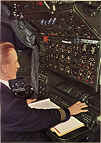 |
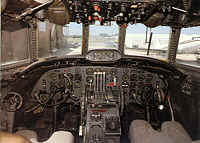 |
 |
| Mechanic's "organ" just behind cockpit |
Cockpit view unobstructed by foolish grinners |
Pantry with a real cook! |
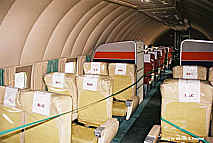 | Super-G Cabin Interior | 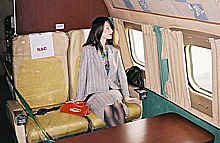 |
More Famous Aircraft
KLM's


model drawings available from
Modelbouwers
SEARCH this site or the Web

copyright notice
all material on this site, except where noted
copyright © by , curaçao
reproduction in any form for any purpose is prohibited
without prior consent in writing